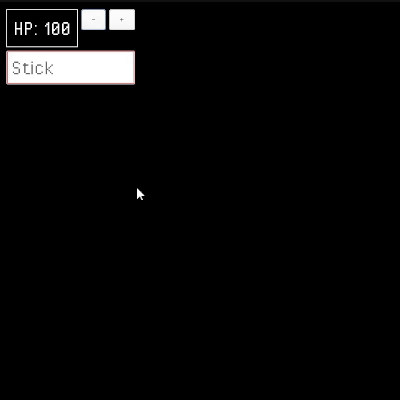I was banging my head against the wall trying to get Domkit working with Heaps. I spent around 8 hours trying to get a data store working with components.
I decided to try HaxeUI, and it only took me about an hour to get it up and running.
Here is the demo code for anybody that is looking to get started.
Spacebar shows and hides the HUD component.
H updates the HP label.
I adds a fish to your inventory.

compile.hxml:
-cp src
-lib heaps
-lib domkit
-lib haxeui-core
-lib haxeui-heaps
-js game.js
-main Main
src/Main.hx:
import haxe.ui.core.ItemRenderer;
import haxe.ui.core.Screen;
import haxe.ui.*;
import haxe.ui.containers.*;
import haxe.ui.components.*;
import haxe.ui.data.*;
@:xml('
<box height="100%" width="100%">
<style>
.custom {
color: #FFFFFF;
border: 1px solid #FFFFFF;
padding: 10px;
font-size: 24px;
}
</style>
<vbox>
<hbox>
<label id="textfield" styleName="custom" text="0" />
<button id="deinc" styleName="red" text="-" />
<button id="inc" text="+" />
</hbox>
<listview id="inventory" width="100%">
<item-renderer id="inventoryList" layoutName="vertical" width="100%" style="border: 1px solid #ff0000;">
<label id="itemName" style="font-size: 24px;" text="0" width="100%" />
</item-renderer>
</listview>
</vbox>
</box>
')
class HUDComponent extends Box {
public function new() {
super();
// anything with an id becomes a correctly typed member variable
textfield.text = "HP: " + Main.hp;
deinc.onClick = function(e) {
Main.hp = Std.string(Std.parseInt(Main.hp) - 1);
textfield.text = "HP: " + Main.hp;
}
inc.onClick = function(e) {
Main.hp = Std.string(Std.parseInt(Main.hp) + 1);
textfield.text = "HP: " + Main.hp;
}
// Init Inventory
for (item in Main.inventory) {
inventory.dataSource.add({ itemName: item });
}
// Removes At Index
inventory.onClick = function(e) {
inventory.dataSource.removeAt(inventory.selectedIndex);
Main.inventory.splice(inventory.selectedIndex, 1);
}
}
}
class Main extends hxd.App {
// State
public static var hp:String = '100';
public static var inventory:Array<String> = ['Stick'];
// UI
public static var myComp:HUDComponent;
public static var showHud:Bool = false;
override function init() {
// Initialize HaxeUI
Toolkit.init({root: s2d});
// Add HUD
myComp = new HUDComponent();
Screen.instance.addComponent(myComp);
showHud = true;
}
override function update(dt:Float) {
// Show/Hide Hud
if (hxd.Key.isPressed(hxd.Key.SPACE)) {
if (showHud) {
Screen.instance.removeComponent(myComp);
showHud = false;
} else {
myComp = new HUDComponent();
Screen.instance.addComponent(myComp);
showHud = true;
}
}
// Change Inventory
if (hxd.Key.isPressed(hxd.Key.I)) {
var list = myComp.findComponent("inventory", ListView);
inventory.push("Fish" + Std.random(100));
list.dataSource.clear();
for (item in inventory) {
list.dataSource.add({ itemName: item });
}
}
// Change HP
if (hxd.Key.isPressed(hxd.Key.H)) {
// Increase by 1
Main.hp = Std.string(Std.parseInt(Main.hp) + 1);
myComp.findComponent("textfield", Label).text = "HP: " + Main.hp;
}
}
static function main() {
#if hl
hxd.Res.initLocal();
#else
hxd.Res.initEmbed();
#end
new Main();
}
}
I hope this helps someone, and saves them time!
Edit: Thanks to Ian for the assist.